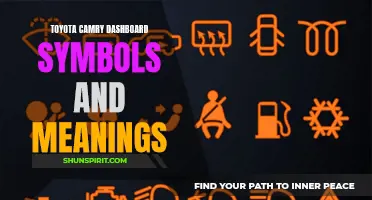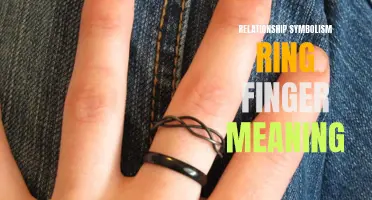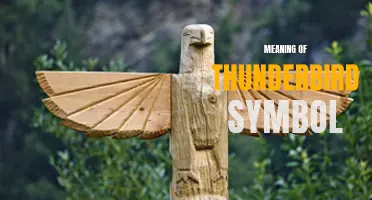
Music is a universal language that has the power to evoke emotions and convey sentiments without uttering a single word. However, even within the realm of music, there are symbols that hold profound meanings and add depth to the melodies that we hear. From the soaring crescendos to the delicate pianissimos, these symbols guide musicians and listeners alike through the intricacies of musical expression. Whether it's a simple dynamic marking or a complex array of ornaments, exploring the symbols of music can help us unravel the hidden messages behind the harmonies and melodies we love.
What You'll Learn
- What are some common symbols used in sheet music, and what do they represent?
- How do the symbols of music, such as a treble clef or a bass clef, affect the pitch of the notes being played?
- Are there any symbols in music that indicate tempo and rhythm What do they look like and how are they used?
- Can you give an example of a symbol in music that represents a specific style or genre?
- How do symbols in music, such as dynamics markings or articulation symbols, affect the overall expression and interpretation of a piece?

What are some common symbols used in sheet music, and what do they represent?
Sheet music is a written form of musical notation that uses a variety of symbols to represent different elements of a piece of music. These symbols convey important information to the musician, such as pitch, duration, dynamics, and expression. Understanding these symbols is essential for reading and interpreting sheet music accurately. Here are some common symbols used in sheet music and what they represent.
- Clefs: Clefs are symbol used at the beginning of a musical staff to indicate the pitch range of the notes. The most common clefs are the treble clef (G clef), which is used for higher-pitched instruments like the piano, violin, and flute, and the bass clef (F clef), which is used for lower-pitched instruments like the cello, trombone, and bass guitar.
- Notes: Notes are symbols that represent the pitch of a sound. The shape and position of the note on the staff determine its pitch. Common types of notes include whole notes, half notes, quarter notes, and eighth notes, each indicating a specific duration.
- Rests: Rests are symbols that indicate periods of silence in a piece of music. They have the same values as their corresponding notes. For example, a whole rest indicates a whole note rest, while a quarter rest indicates a quarter note rest.
- Time signatures: Time signatures indicate the meter or rhythm of a piece of music. They consist of two numbers stacked on top of each other. The top number represents the number of beats per measure, while the bottom number indicates the note value that receives one beat. For example, a time signature of 4/4 means there are four beats per measure, and a quarter note receives one beat.
- Dynamics: Dynamics symbols indicate the volume or intensity of a musical passage. Common dynamic markings include pianissimo (pp) for very soft, piano (p) for soft, mezzo piano (mp) for moderately soft, mezzo forte (mf) for moderately loud, and forte (f) for loud.
- Articulation marks: Articulation marks indicate how a note or passage should be played. For example, a staccato mark indicates that a note should be played short and detached, while a slur indicates that a series of notes should be played smoothly.
- Pedal markings: Pedal markings indicate when and how the sustain pedal on a piano should be used. Common pedal markings include "ped" for depressing the pedal, "una corda" for using the left pedal, and "sostenuto" for using the middle pedal.
- Repeat signs: Repeat signs indicate that a section of music should be played again. Common repeat signs include the double bar with two dots at the beginning and end of the repeated section, as well as the D.C. al fine sign, which indicates to repeat from the beginning until reaching the word "fine."
These are just a few of the many symbols used in sheet music. Learning to read and interpret these symbols is a valuable skill for any musician, as it allows them to accurately and expressively perform a piece of music. Practice and familiarity with sheet music symbols will lead to improved musicianship and a deeper appreciation for the art of music.
Unleashing The Power: Exploring the Symbolic Meaning of the Fist
You may want to see also

How do the symbols of music, such as a treble clef or a bass clef, affect the pitch of the notes being played?
Music is a universal language that is appreciated by people all around the world. From classical compositions to contemporary pop songs, music is a combination of different notes, melodies, and rhythms. But have you ever wondered how the symbols of music, like the treble clef or the bass clef, affect the pitch of the notes being played? Let's explore this fascinating topic to understand how these symbolic representations influence the pitch of the music we hear.
Before delving into the symbols, it's important to have a basic understanding of pitch. Pitch refers to the perceived frequency of a sound. Every sound is created by vibrations, and the frequency of these vibrations determines the pitch. Higher frequencies result in higher pitches, while lower frequencies produce lower pitches.
Now, let's discuss the treble clef and the bass clef and their impact on pitch. The treble clef, also known as the G clef, is commonly used to notate higher-pitched instruments like the violin, flute, or piano's right hand. It is easily recognizable by its curly shape that wraps around the second line from the bottom on the staff. The positioning of the treble clef on the staff indicates that the notes within its range are higher in pitch.
On the other hand, we have the bass clef, also referred to as the F clef. This clef is most often used to notate lower-pitched instruments such as the double bass, cello, or bass guitar. The bass clef is identified by its curved shape with two dots, indicating that the note F is found between the two dots. The placement of the bass clef on the staff indicates that the notes within its range are lower in pitch.
Both the treble clef and the bass clef serve as crucial guides for musicians to read and interpret music accurately. By using these symbols, composers and musicians can easily communicate the intended pitch of the notes in a piece of music. They create a visual representation of the frequency range that each clef is associated with, allowing for more efficient reading and performance.
It's important to note that while the treble clef generally represents higher-pitched notes and the bass clef represents lower-pitched notes, there is some overlap between their range. This overlap is known as the "middle C" or the "C4." It is represented by a small line added below the bass clef or above the treble clef, indicating that it is equidistant from both clefs. This allows for seamless transitions between the registers covered by the treble and bass clefs.
In conclusion, the symbols of music, such as the treble clef and the bass clef, play a crucial role in representing the pitch of the notes being played. The treble clef signifies higher-pitched notes, while the bass clef indicates lower-pitched notes. By using these symbols, musicians can accurately read and perform music, creating a harmonious and well-organized musical composition. So the next time you see a treble clef or a bass clef, remember that these symbols are not just decorative elements but essential tools in understanding and conveying the pitch of the music we enjoy.
The Symbolism and Meaning Behind Red Bottom Shoes
You may want to see also

Are there any symbols in music that indicate tempo and rhythm? What do they look like and how are they used?
Tempo and rhythm are essential elements in music that help convey the mood and structure of a piece. To indicate these aspects, composers use a variety of musical symbols and notations. These symbols provide performers with specific instructions regarding the speed and timing of the music.
One of the most common symbols used to indicate tempo is the Italian term written above the staff, such as "Allegro" (fast), "Moderato" (moderate), or "Adagio" (slow). These terms give a general indication of the desired speed, but they are subjective and open to interpretation.
In addition to the Italian terms, composers also use metronome markings to provide a more precise indication of tempo. These markings consist of a number, representing the beats per minute (BPM), written above a note symbol. For example, a marking of "120" over a quarter note means that there should be 120 beats per minute, with each quarter note receiving one beat.
Another set of symbols used to indicate tempo are tempo modifiers. These symbols modify the overall tempo by instructing the performer to play faster or slower than the prevailing tempo. For example, "accelerando" instructs the performer to gradually speed up, while "ritardando" instructs a gradual slowing down of the tempo. These symbols are typically written above the staff and are accompanied by an arrow indicating the direction of the change.
To convey the rhythm of a piece, composers use a variety of musical notation symbols. One of the most common rhythm indicators is the time signature, which consists of two numbers stacked on top of each other at the beginning of a piece or section. The top number indicates the number of beats per measure, while the bottom number indicates the type of note that receives one beat. For example, a time signature of 4/4 means there are four beats per measure, and a quarter note receives one beat.
Additionally, composers use note values to indicate the duration of individual notes. A whole note represents four beats, a half note represents two beats, a quarter note represents one beat, an eighth note represents half a beat, and so on. These note values are combined with flags or beams to indicate shorter durations.
Rests are also used to indicate periods of silence within a musical composition. Rests have the same shapes and values as notes but are positioned on the staff differently. A whole rest indicates four beats of silence, a half rest indicates two beats, a quarter rest indicates one beat, and so on.
In addition to these symbols, composers may include various articulation markings, dynamics, accents, and other expressive markings to further clarify the intended rhythm and tempo of a piece.
Overall, musical symbols play a crucial role in indicating tempo and rhythm in music. These symbols provide performers with important instructions and guidelines on how to interpret and perform a piece, ensuring that the desired mood and structure of the music are effectively conveyed.
Decoding the Meaning Behind Mahjong Symbols: Unveiling the Secrets of an Ancient Game
You may want to see also

Can you give an example of a symbol in music that represents a specific style or genre?
Symbols in music are often used to represent different styles or genres. These symbols can be visual, musical, or textual, and they help listeners identify and categorize the music they are hearing. One example of a symbol that represents a specific style or genre is the electric guitar.
The electric guitar is a symbol of rock music. When most people think of rock music, one of the first images that come to mind is a guitarist shredding on an electric guitar. This instrument is closely associated with the genre and has become a defining symbol of rock music.
The sound of an electric guitar is loud, distorted, and often accompanied by power chords and aggressive playing techniques. It has a raw, rebellious quality that perfectly matches the spirit of rock music. From the early days of pioneers like Chuck Berry and Jimi Hendrix to modern rock bands like Foo Fighters and Arctic Monkeys, the electric guitar has been an integral part of the genre.
Beyond its sound, the electric guitar is also visually distinctive. It is often seen as a symbol of rebellion and youthful energy. The image of a guitarist with a guitar slung low on their hip, playing with passion and intensity, is quintessentially rock 'n' roll.
In addition to the electric guitar, other symbols represent different music genres. For example, the turntable is a symbol of hip-hop and DJ culture. The distinctive scratching and mixing techniques used by DJs on turntables have become synonymous with the genre. Similarly, the accordion is a symbol of traditional folk music in many cultures, while the piano is often associated with classical music and sophistication.
Symbols in music help listeners connect to a particular genre or style. They serve as visual and auditory cues that we use to identify and categorize music. Whether it's the electric guitar in rock music, the turntable in hip-hop, or the piano in classical music, these symbols enhance our understanding and appreciation of different genres.
The Symbolic Meaning Behind the Mitsubishi Logo
You may want to see also

How do symbols in music, such as dynamics markings or articulation symbols, affect the overall expression and interpretation of a piece?
Symbols in music, such as dynamics markings or articulation symbols, play a crucial role in enhancing the overall expression and interpretation of a piece. These symbols provide musicians with important instructions on how to perform certain passages or sections, and they help convey the composer's intentions to the performer and the listener.
Dynamics markings, such as piano (soft) or forte (loud), indicate the volume at which a particular passage or section should be played. These markings give musicians a clear indication of the desired dynamic level, allowing them to create contrast and shape the music. Dynamics can change throughout a piece to reflect different emotions or moods, and they can greatly impact the overall expressiveness of the music.
Articulation symbols, on the other hand, provide instructions on how to play each note or passage. They indicate whether a note should be played short or long, with precision or with a slur, with a staccato or legato technique, and so on. Articulation symbols help shape the character and phrasing of the music, allowing the performer to convey the composer's intended style and mood.
The combination of dynamics and articulation symbols allows musicians to bring out the nuances and subtleties of the music. For example, a passage marked fortissimo with a staccato articulation will have a strong and crisp sound, while the same passage marked pianissimo with a legato articulation will have a soft and smooth sound. Additionally, changes in dynamics and articulation within a piece can create tension, release, or a sense of excitement.
Interpreting these symbols requires the musician to have a deep understanding of the composer's intentions, as well as a high level of technical skill. It is not simply a matter of following the markings on the page, but rather bringing a personal interpretation to the music while staying true to the composer's vision. This requires a sensitivity to the music, careful attention to the details, and the ability to make artistic choices.
Ultimately, the symbols in music serve as tools to guide performers in creating a meaningful and expressive performance. They provide a framework for interpretation and allow musicians to convey emotions, tell stories, and connect with listeners on a deeper level. As both performers and listeners, we can appreciate the transformative power of these symbols and the impact they have on our experience of music.
The Hidden Meaning Behind Eating Disorder Tattoo Symbols and How They Empower Recovery
You may want to see also
Frequently asked questions
The treble clef symbol, also known as the G clef, is commonly found at the beginning of the staff in sheet music. It indicates that the lines and spaces of the staff correspond to specific pitches on the piano or other instruments. The treble clef is used to notate higher pitched instruments such as the violin, flute, or trumpet.
The bass clef symbol, also known as the F clef, is another common symbol used in sheet music. It is placed at the beginning of the staff and indicates that the lines and spaces correspond to lower pitches on the piano or other instruments. The bass clef is typically used for lower-pitched instruments like the bass guitar, cello, or trombone.
The flat symbol, represented by a lowercase "b", is used to lower the pitch of a note by a half step. When a note is flatted, it is played one semitone lower than its natural position. For example, if a note is written as a B flat, it is played as B♭ instead of B.
The sharp symbol, represented by the "#" symbol, is used to raise the pitch of a note by a half step. When a note is sharpened, it is played one semitone higher than its natural position. For example, if a note is written as A#, it is played as A♯ instead of A.
The fermata symbol, represented by a curved arc placed above a note, is used to indicate that the note or rest should be held longer than its written value. The musician is meant to hold the note until the conductor or performer decides to end it. This symbol allows for flexibility in timing and expression within a musical piece.







